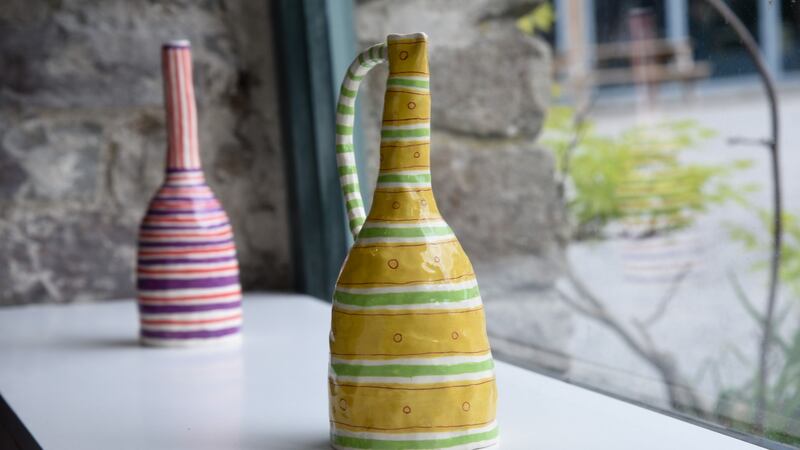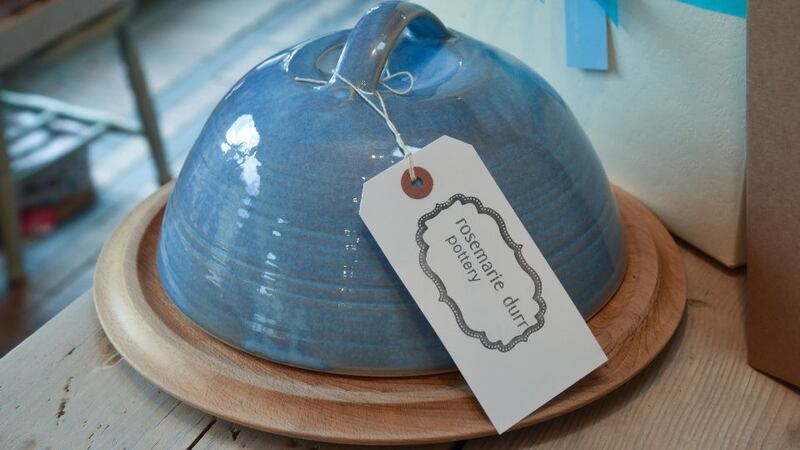The woodlands of Castlecomer are thick with bluebells. They reflect the sense of calm this sprawling country estate in Co Kilkenny evokes.
Dating from the 1600s, the 80-acre estate is currently enjoying a popular cultural and educational revival. Castlecomer grew up around the anthracite coal mines of the county. The grounds, the man-made lakes and the woodland walks were forged by the Wandesfordes, an English family that moved from Yorkshire to manage the mines and the estate tenants.
Ceramicist and potter Rosemarie Durr meets me in the old gardener’s cottage, a beautiful cut-stone house near her studio and shop in the courtyard of the estate. It’s not her home but a part of the estate that she is incredibly fond of and her work is on the shelves and cupboards of the picturesque building. Sheep and pigs wander up to the door to investigate who is visiting this working farm and the world drops away as Durr shows me around.

We’re joined by her husband Andrew Ludick, also a ceramicist, who shares her studio space in the main courtyard. They’ve been here for 13 years, creating two growing bodies of work that are distinctly different from each other but both very rooted in their surroundings.
“There’s a lovely feeling of history and heritage in this place,” Durr explains. “The garden is a huge inspiration for my work. Each season brings something new and you’re constantly steeped in countryside and nature.” It has its own pace she says. “Slow living is where we’re at.”
Neither is Kilkenny born but they are very much at home here. Andrew Ludick is an American who talks with pride of his Ohio upbringing and the desire to bring the same sense of family and comfort to their children as he enjoyed himself.
Durr is from Roscommon, where life on a busy family farm shaped an appreciation for carrying tradition and care and a sense of home within you. Together they convey a very rounded sense of the place in the world they hope their family occupies.
The arrival of their two young children has brought a simplification to her work Durr says. “Time is no longer my own. Family life dictates so much and so I needed to simplify things and introduce a sense of control in my work.”
Her latest collection, the Stacking Range, is based on 1950s industrial German slip-cast ceramics. “It’s a collection that is based on uniformity that has an industrial edge and is so different to the freeform work I did in the past.” Every piece has to be perfectly formed, there is no room for error.

Where she once revelled in the freedom of making each piece as its own entity, she says, she now thrives on streamlining her production process for this latest collection.
Ludick’s work is changing too. An anthropomorphic quality defines his colourful, almost sculptural pieces, which he says are not at all utilitarian.
“My work has changed a lot – the build up of colours and shapes have seen me being drawn back to sculpture. I do a lot of sketches and then work to bring them to life in clay. The pieces are becoming larger too and more experimental.”

Ludick and Durr met while the former was backpacking around Ireland. Durr then had a studio in the Castle Yard in Kilkenny and was already an established potter. Ludick had studied pottery as a student but it was only in Ireland that he became a ceramicist, transferring his then focus on illustration to clay. “So many options suddenly became available,” he says of his move to ceramics. “It made so much sense to me.”
Durr also moved disciplines to find her place at the potter’s wheel. Having trained in graphic design she credits a night class to the moment when she found her true calling.
“The minute I touched the clay I thought ‘I want to do more of this’,” she says. “It was so immediately therapeutic. I’m very much a maker and very practical. My work must be functional and fit in a home or someone’s life and this allowed that to happen.”

Both designers say time matters in their work. “You have to live with new pieces,” Durr explains. “I need to use them and decide if this is the best solution to a problem. It can be a year or two before they end up in my shop.”
The studio and shop is at the heart of their work but they both have an international following selling online and in other stores. Ludick has designed for the US chain Crate and Barrel as well as a series of renowned designs for Ceadogán Rugs.

Both their businesses are growing steadily, they say. There’s a healthy group of people who like to collect ceramics and who follow your journey over a long time, they explain. “We’re collectors too and like to fill our home with different pieces that are functional but carry emotion or meaning. You might not always be aware of it but when a piece is made, some sense of the maker goes into that,” Ludick explains. “It’s perhaps why we choose one cup over another on any given day. You’re drawn to a piece depending how you feel and how it makes you feel.”
They’re both very aware that their work has to play a part in other people’s homes too. There’s a responsibility in that, they say, and the idea of home for them both is a very real one. “My memories of home are emotional ones,” Durr explains. “They’re of the warm range, the kettle on the boil, fresh bread, and milk in a jug no matter how busy family life was. Things of beauty shaped our lives through generations and that’s all about tradition.

“Today life is so disposable and fast, she says. “We like to believe that if you can keep these traditions inside, you can make a home anywhere because they come from within you.”
Home is not dictated by a building, she says. “Whatever you have to work with will bring that sense of love and the values behind that are worth passing on to the next generation. This in turn will give them something to hold on to – a sense of belonging.”
“When you bring something that is handmade into your home you have a relationship of sorts with the person who made it,” Ludick says. “It’s like having a guest in your home.”
For more see rosemariedurr.com and andrewludick.com
About the Story of Home series
The Story of Home, in association with Ulster Bank, is a six-part weekly print, video and online editorial series that explores the idea of home through the eyes and work of Irish designers.
We are all writing our own Story of Home and, to help inspire you, we've turned to a group of people who have made design for the home the core of what they do.
Staff at Ulster Bank are also helping to write that story: "Meeting customers in an environment in which they are comfortable in or near their place of work or at home at a convenient time is the big positive about the role," says mobile mortgage manager Niall Mac-Sweeney.
"The customer doesn't have to worry about traffic, taking time off work, being late for an appointment - we take away all that stress from them. It allows for a much more free-flowing conversation in terms of what the client wants and what we can do to help them.
"I suppose the main reaction to the mobile mortgage manager role that I have noticed is the positive reaction to the flexibility of the role," he says. "Recently I completed a self-build drawdown for a client in Connemara. When I met with them last autumn in their family home there, the first comment to me was 'nobody from a bank was ever seen around here before.'"
"Our role is to make the whole process as easy as possible," he explains. "So to hear this is a great confirmation that we're doing something right."
For more see ulsterbank.ie










